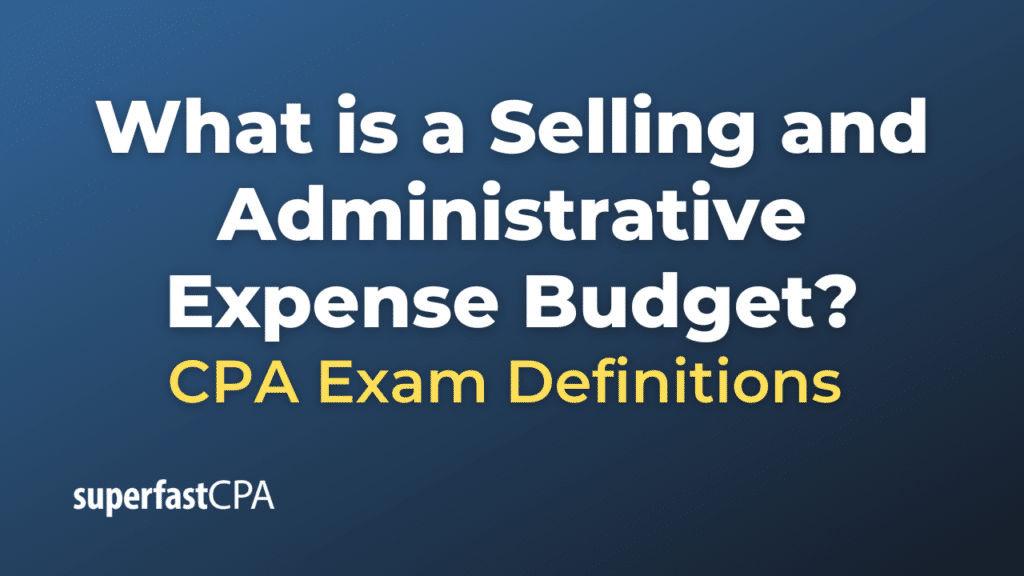Selling and Administrative Expense Budget
The selling and administrative expense (S&A) budget is a detailed projection of the expenses a company expects to incur in its selling (sales) and administrative functions over a specific period, typically a fiscal quarter or year. This budget is part of the master budget and is used to forecast the costs associated with supporting the company’s sales efforts and managing its overall operations.
The S&A budget helps businesses plan for costs, control spending, and ensure that sufficient funds are allocated to the company’s sales and administrative functions.
Here are typical items you might find in an S&A budget:
- Selling Expenses:
- Salaries and commissions for the sales team.
- Travel and entertainment costs related to sales efforts.
- Advertising and promotion expenses.
- Freight and shipping charges.
- Depreciation on sales equipment and vehicles.
- Administrative Expenses:
- Salaries of administrative staff (e.g., executive salaries, clerical staff wages).
- Office supplies and equipment expenses.
- Rent for office space or administrative buildings.
- Utilities (like electricity, water, and internet) for the office.
- Insurance and legal fees.
- Depreciation on office equipment and buildings.
- Other general overhead costs.
Steps to Prepare the S&A Expense Budget:
- Start with Historical Data : Review prior periods’ expenses to provide a basis for the current period’s budget. Adjust for any known changes or anticipated fluctuations.
- Forecast Sales Activity : Before estimating selling expenses, it’s essential to forecast expected sales volumes as certain selling expenses, like sales commissions, are directly tied to sales activity.
- List Fixed and Variable Costs: Identify which costs remain relatively constant regardless of sales volume (fixed costs) and which ones fluctuate with sales activity (variable costs).
- Consider Upcoming Changes: Factor in any planned changes, like hiring more staff, launching a new ad campaign, or moving to a larger office space.
- Consolidate and Review: Once all expenses are listed and projected, consolidate them to get a total estimated S&A expense for the period. Review the budget to ensure it aligns with the company’s strategic objectives and financial constraints.
- Approval and Implementation: The budget often goes through a review and approval process, usually involving senior management or the board of directors. Once approved, it serves as a guide and benchmark for actual performance.
Throughout the budgeted period, the actual selling and administrative expenses are compared to the budgeted amounts to monitor any variances. Management can then make informed decisions about adjusting operations or revising the budget based on these variances.
Example of a Selling and Administrative Expense Budget
Let’s create a simple example of a Selling and Administrative Expense Budget for a fictional company called “TechGlow Electronics.”
TechGlow Electronics Quarterly S&A Expense Budget for Q1 2023
- Sales Team Salaries: $50,000
- Sales Commissions (5% on projected $500,000 sales): $25,000
- Travel and Entertainment for Sales: $10,000
- Advertising Campaign: $30,000
- Freight and Shipping: $8,000
- Depreciation on Sales Equipment: $5,000
Total Selling Expenses: $128,000
- Executive Salaries: $75,000
- Clerical Staff Wages: $40,000
- Office Supplies: $3,000
- Rent for Administrative Office: $15,000
- Utilities (Electricity, Internet): $4,000
- Insurance: $6,000
- Depreciation on Office Equipment: $2,000
Total Administrative Expenses: $145,000
Total S&A Expenses for Q1 2023: $273,000
Throughout Q1, TechGlow would monitor its actual expenses compared to this budget. For example, if by halfway through the quarter, they’ve already spent $20,000 on office supplies (way above the $3,000 budgeted), this might prompt an investigation and adjustment to either spending practices or the budget.
Conversely, if they’ve only spent $2,000 on advertising out of the $30,000 budgeted by the end of the first month, management might decide to launch a new ad campaign to boost sales or re-evaluate their marketing strategy.
This budget serves not only as a planning tool but also as a control mechanism to ensure that TechGlow remains on track with its financial goals and can adjust accordingly if they’re not.














